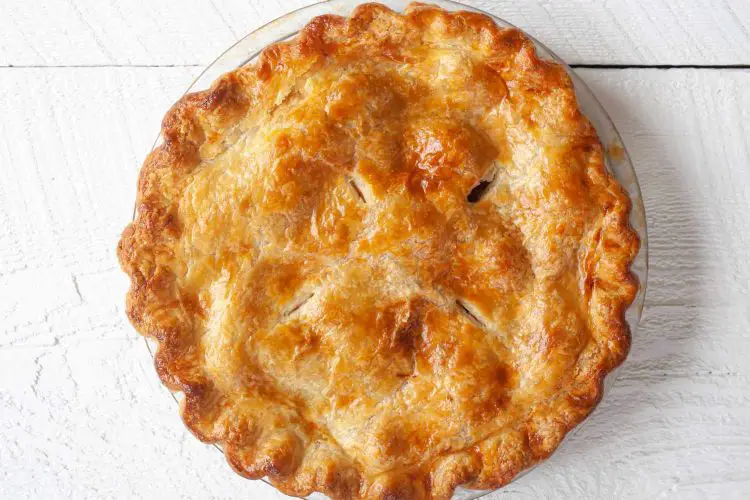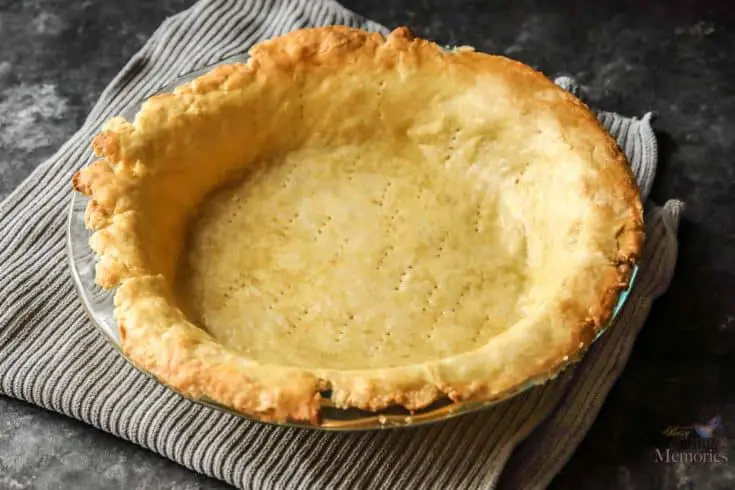Making a delicious, flaky pie crust from scratch can be intimidating — but it doesn’t have to be!
With the right technique and measurements, baking an impressive homemade pastry is straightforward and fun.
In this guide, we’ll walk through all the tips and tricks you need for crafting a perfect pie crust every time.
Whether you’re a novice baker or an experienced pro with rolling pins in hand, there are things here for everyone.
Contents
How Thick Should Pie Crust Be?
Pie crust thickness is typically determined by the type of pie being made.
For example, a double-crust pie such as an apple or cherry requires a thicker crust than a single-crust custard or cream pie.
Generally speaking, it is best to use between 1/8 inch and ¼ inch thickness when making any kind of crust.
When using a standard 9-inch pie pan, you should roll out the bottom crust to between 11 and 12 inches in diameter.

This will help ensure the crust is big enough to fit the pan with some extra overhang for crimping or fluting the edges. If your recipe requires a thicker or thinner crust, adjust accordingly by rolling the dough out larger or smaller.
When using a tart pan, you should roll the crust to 1/8 inch thick and make sure it is at least 1/2 inch larger than the pan itself. This will help account for any shrinking of the dough as it bakes.
What Are the 4 Types of Pie Crust?
Thankfully, there are a few different types of pie crusts that work perfectly for different occasions.
Let’s explore each type and how to best use them.
1. Shortcrust Pie Crust
Shortcrust pastry is made with shortening, butter, or lard. This type of pastry crumbles easily when cut into pieces and has a delicate, flaky texture.

Shortcrust is ideal for making pies like quiches or tartlets because it doesn’t require baking before adding the filling.
It’s also used for sweet pies such as apple pie and cherry pie because it provides a nice balance between sweetness and crunchiness in each bite.
2. Puff Pastry Pie Crust
Puff pastry is made with layers of dough and fat such as butter or margarine. The layers of dough are rolled out several times until they become very thin, creating hundreds of paper-thin layers within the dough itself.
When baked, this produces a light, flaky crust with an airy texture that pairs well with fruit fillings like peach or blueberry pies.
It’s also great for savory dishes like quiche Lorraine or spinach pies because it adds an extra layer of flavor to each bite.
3. Graham Cracker Pie Crust
Graham cracker crusts are made by combining crushed graham crackers with melted butter and sugar to form a crumbly mixture that can be pressed into the bottom and sides of a pie plate.
Graham cracker crusts are great for no-bake desserts like cheesecake since they provide a nice crunch without needing to be pre-baked.
They’re also popular for their sweet flavor that pairs well with ice cream pies or lemon meringue pies.
4. Filo Dough Pie Crust
Filo dough is made from thin sheets of unleavened dough that are layered together and brushed with melted butter or oil before baking.
This creates a crispy, golden-brown crust that complements both sweet and savory fillings alike – such as baklava or spanakopita – beautifully!
Filo also holds up well under heavier ingredients like cheese so it’s perfect for making quiches or pot pies too!
Why Do You Put Butter Under a Pie Crust?
Butter is a key ingredient in most pie crusts because it adds flavor, and moisture, and helps the dough to rise.
When placed under the crust, it helps provide insulation from the heat of the oven which keeps the bottom layer from becoming too dark.
Additionally, when the butter melts during baking it creates steam pockets that help make the crust flaky and light. For this reason, it’s always a good idea to add butter when making pie crusts.
When using butter, it’s best to chill the dough before baking so that the butter won’t melt too quickly in the oven. Doing this will help ensure your finished crust is as flaky and light as possible.
So whether you’re making a sweet or savory pie, adding butter to your crust is essential for achieving the perfect balance of flavor and texture.
With these tips, you can make delicious pies with ease and confidence!
What Is a Trick to Making a Good Pie Crust?
One of the best tricks for making a perfect pie crust is to keep everything cold. This includes the butter, lard, or shortening and even your work surface.
Make sure to measure out all of your ingredients before beginning and then place them in the refrigerator while you prepare your dough.
When rolling out the dough, make sure your work surface is lightly floured and cold. This will help prevent the dough from sticking and make it easier to shape.
Finally, once your pie crust has been formed, place it in the refrigerator or freezer for 15 minutes before baking. This helps keep all of the ingredients cold which results in a flaky, light crust with maximum flavor.
By following these simple tips, you can make a perfect pie crust every time!
Is Pie Crust Better With Butter or Crisco?
Both butter and Crisco are commonly used to make pie crusts.
Butter is a great choice because it adds flavor and moisture, while Crisco has a higher melting point which makes for a flakier crust and helps it hold its shape better during baking.
The best choice depends on the type of pie you are making. If you are making a savory pie with heavy ingredients, then Crisco is the better option.
However, if you are making a sweet pie that requires a light and flaky crust, then butter will be your better choice. You can also combine both to get the best of both worlds!
Should You Poke Holes in the Bottom of Pie Crust?
When preparing a pie crust, it is important to poke holes in the bottom of the crust before baking. This helps create air pockets which will prevent air bubbles from forming and ensure that your crust remains flat and even.
It also allows steam to escape which will help give you a flaky, light crust with no soggy spots. To poke holes in the crust, use a fork or thin skewer and lightly press down into the dough.
Doing this will help ensure your pie comes out looking and tasting perfect – every time!
Should I Bake the Bottom Pie Crust First?
Yes, it is a good idea to pre-bake or “blind-bake” your bottom pie crust before adding the filling. This helps to cook the dough and prevent it from becoming soggy when added to the filling.
When blind baking, place a piece of parchment paper over the uncooked crust and fill it with pie weights or dried beans. This will help to keep the dough in place while it bakes.
Once the crust is lightly golden brown, remove the parchment paper and pie weights or beans before adding your filling. Baking the bottom crust first helps ensure that you get a light, flaky crust every time!
How Do I Make My Pie Crust More Crispy?
If you want a crispier pie crust, there are several things you can do.
- First, make sure to use cold butter or shortening and chill the dough before baking. This will help create flaky pockets which will give your crust more texture and flavor.
- Next, reduce the amount of water in your recipe. Lower water content will help keep the crust from becoming soggy.
- Finally, use a higher oven temperature when baking your crust. This helps to reduce moisture and create an even crispness throughout.
By following these simple tips, you can make a delicious and crispy pie crust every time!
What Temperature Do You Bake Pies At?
Most pies are baked at 375-400°F (190-200°C). This temperature range is hot enough to cook the filling and crust evenly, but not too hot that the edges of your crust become overly browned.
If you want to create a crispier bottom crust or bake a custard pie, then you will need to pre-bake the crust at a higher temperature until it is golden brown. This will help ensure your pie comes out looking and tasting perfect – every time!
When baking pies, use a good-quality oven thermometer and check the temperature of your oven before you start to make sure it is correct.
How Do You Keep the Bottom Crust of a Pie From Getting Soggy?
The best way to prevent your bottom crust from becoming soggy is to pre-bake it. This helps to cook the dough and prevent it from absorbing any moisture from the filling.
- When blind baking, place a piece of parchment paper over the uncooked crust and fill it with pie weights or dried beans. This will help to keep the dough in place while it bakes.
- Once the crust is lightly golden brown, remove the parchment paper and pie weights or beans before adding your filling.
- You can also brush an egg wash over the bottom of your crust before baking. This helps to create a seal which will prevent any moisture from seeping into the crust.
By following these simple steps, you can ensure that your bottom crust stays perfectly crisp and delicious – every time!
What Is the Difference Between Pastry Crust and Pie Crust?
Let’s take a look at what sets these two types of crusts apart.
1. Ingredients
The primary difference between pastry crust and pie crust is in their ingredients.
Pastry crust typically includes butter, flour, salt, and water; whereas pie crust will usually contain either butter or lard (or sometimes both).
The fats used in pie crust are usually more solid than those used in pastry dough, making it easier to roll out the dough without it falling apart.
Pie crust also tends to have more sugar added than pastry dough does.
2. Methods of Preparation
The method for preparing each type of dough is also different.
For the pastry dough, you will typically combine all ingredients together before shaping it into a ball and refrigerating it for at least 30 minutes before rolling out the dough. This helps ensure that the fat remains solid while you work with the dough.
For pie crusts, you will mix together your dry ingredients first and then gradually add your fat until it is fully incorporated into the mixture before refrigerating it for at least 30 minutes prior to rolling out your dough.
3. Baking Times
Another key difference between these two types of dough is the baking time required for each one.
Pastry dough must be baked longer than pie dough because of its higher fat content; this helps ensure that the fat melts evenly throughout the entire product during baking, resulting in a flaky texture.
Pie crust requires less baking time because its lower fat content makes it less likely to burn quickly during baking.
However, this also means that pie crust may not be as flaky as pastry dough due to its lower fat content.
How Do You Measure the Thickness of a Pie Crust?
The thickness of your pie crust is important for ensuring that it cooks evenly and doesn’t become soggy.
The best way to measure the thickness of a pie crust is to use a rolling pin guide. This is simply a small metal or plastic rod that slides over your rolling pin and has markings on it indicating how thick the dough is.
Once you have rolled out your dough to the desired thickness, place the rolling pin guide over it and press down firmly.
This will help you to accurately measure how thick your pie crust is so that you can ensure it cooks evenly.
You can also use a ruler or measuring tape if you don’t have a rolling pin guide.
Simply measure from one edge of the dough to the other, ensuring that you are measuring in an even manner.
What Should the Diameter of a Rolled Out Pie Crust Be?
The diameter of a rolled-out pie crust should be 2-3 inches wider than the circumference of your pie plate.
This will ensure that you have enough dough to fit into the dish and fold over the edges, creating a nice crimp or decorative edge.
If you are making a double-crust pie, then make sure to roll out both pieces of dough to the same size.
This will ensure that they fit together nicely once you are ready to assemble your pie.
By following these simple tips, you can easily prepare a delicious and perfectly crisp bottom crust every time. Enjoy!
When Rolling Out a Pie Crust How Big Should You Roll It?
When rolling out a pie crust, you should roll it out to a diameter of 2-3 inches wider than the circumference of your pie plate. This will ensure that you have enough dough to fit into the dish and create a nice crimp or decorative edge around the edges.
If you’re making a double-crust pie then make sure to roll out both pieces of dough to the same size. This will ensure that they fit together nicely once you are ready to assemble your pie.
To measure the diameter of your rolled-out dough, you can use a rolling pin guide or even a ruler or measuring tape. Place them over the center of your rolled-out dough and press down firmly to ensure that you are measuring in an even manner.
How Big Is a Pillsbury Pie Crust?
A Pillsbury Pie Crust usually comes in a 9-inch size and is meant to fit into an 8 or 9-inch pie plate. However, you can also find larger sizes (10 inches) available at some stores as well.
When using a Pillsbury Pie Crust, it is important to remember that you should still roll it out to a size that is 2-3 inches wider than the circumference of your pie plate.
This will ensure that you have enough dough to fit into the dish and fold over the edges, creating a nice crimp or decorative edge.
Conclusion:
There you have it – 4 types of pie crusts that can be used in many different ways!
Shortcrust works great for quiches and tarts, puff pastry adds light flakiness to fruit fillings like peach pies, graham cracker makes no-bake desserts simple to assemble, and filo dough is perfect for both sweet baklava dishes as well as savory pot pies!
With many options available at your fingertips, you’re sure to find just what you need when making your favorite pie recipes!
Making a delicious pie starts with the right crust. Whether you opt for traditional shortcrust, puff pastry, graham crackers, or filo dough, there are lots of options to choose from that will work for both sweet and savory dishes.
By following the tips above, you can make a delicious pie crust that will perfectly complement your favorite fillings and guarantee a beautiful result no matter what you’re baking!
Amazon and the Amazon logo are trademarks of Amazon.com, Inc, or its affiliates.

